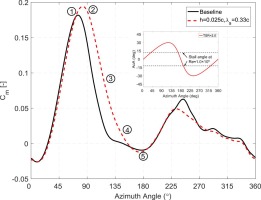Applied Energy ( IF 10.1 ) Pub Date : 2017-09-15 , DOI: 10.1016/j.apenergy.2017.09.034 Zhenyu Wang , Mei Zhuang

|
The performance of vertical-axis wind turbines (VAWTs) are substantially affected by the phenomenon of dynamic stall which is induced by the variations of angle of attack of rotating blades, especially at low tip-speed-ratios (TSRs). Large and sudden torque fluctuations are observed to take place when the dynamic stall vortices, formed near the blade leading-edge, are transported downstream. At low TSRs (λTSR < 4) and relatively low Reynolds number (Re < 105), dynamic stall occurs periodically during the rotation of turbine blades. This results in a sharp drop in lift coefficient and therefore rotor torque and power output are essentially reduced. The purpose of the present study is to investigate the concepts for improving the power performance of a conventional H-type VAWT model by implementing sinusoidal serrations on the leading-edge of turbine blades to control the dynamic flow separation at low TSRs. A thorough numerical study has been carried out to obtain the detailed flow fields for analysis and visualization. The power output results show that the improved turbine design with the sinusoidal serration profile of the wave amplitude h = 0.025c and the wavelength λs = 0.33c not only increases the power generation at low TSRs, but also enhances the capability of wind energy extraction at the optimal TSR in comparison to the baseline model. The flow separation is significantly controlled in the azimuth angle ranges from 75° to 160°, where the positive torque generation is also found to be considerably increased in the improved turbine model. Counter-rotating vortex pairs are generated due to the existence of serrations, which suppress the flow separation, especially in the regions near the peak-serration sections. Additionally, the lift coefficients illustrate a delay of occurrence of dynamic stall and a notable improvement of maximum lift in the improved wind turbine model in comparison to the baseline model. The effects of Reynolds number variation also reveal that the improved model would gain more benefits in power generation at low Reynolds number compared with that at high Reynolds number. The simulated results demonstrate that the leading-edge serration strategy could be an effective solution to control the dynamic stall in the operation of VAWTs.
中文翻译:

尖端锯齿状结构可在低叶尖速比下提高垂直轴风力发电机的性能
垂直轴风力涡轮机(VAWT)的性能很大程度上受动态失速现象的影响,动态失速现象是由旋转叶片的迎角变化引起的,尤其是在低叶尖速比(TSR)时。当在叶片前缘附近形成的动态失速涡流向下游传输时,会观察到大而突然的转矩波动。在低的TSR(λ TSR <4)和相对低的雷诺数(重 <10 5),动态失速在涡轮机叶片旋转期间定期发生。这导致升力系数急剧下降,因此转子扭矩和功率输出显着降低。本研究的目的是研究通过在涡轮机叶片的前端实施正弦锯齿状锯齿以控制低TSR时的动态流分离来改善常规H型VAWT模型的动力性能的概念。进行了彻底的数值研究,以获得详细的流场以进行分析和可视化。功率输出结果表明,改进涡轮机的设计与波振幅的正弦轮廓锯齿ħ = 0.025 Ç和波长λ小号 = 0.33 Ç与基线模型相比,不仅在低TSR时增加了发电量,而且在最佳TSR时还增强了风能提取能力。在75°至160°的方位角范围内,流量分离得到了显着控制,在改进的涡轮机模型中,正扭矩的产生也得到了显着增加。由于存在锯齿,因此会产生反向旋转的涡流对,从而抑制了流动分离,尤其是在靠近锯齿峰的区域。另外,升力系数说明了动态失速的发生延迟以及与基准模型相比在改进的风力涡轮机模型中最大升力的显着改善。雷诺数变化的影响还表明,与高雷诺数相比,改进的模型在低雷诺数下发电将获得更多收益。仿真结果表明,前沿的锯齿策略可能是控制VAWT运行中动态失速的有效解决方案。











































 京公网安备 11010802027423号
京公网安备 11010802027423号